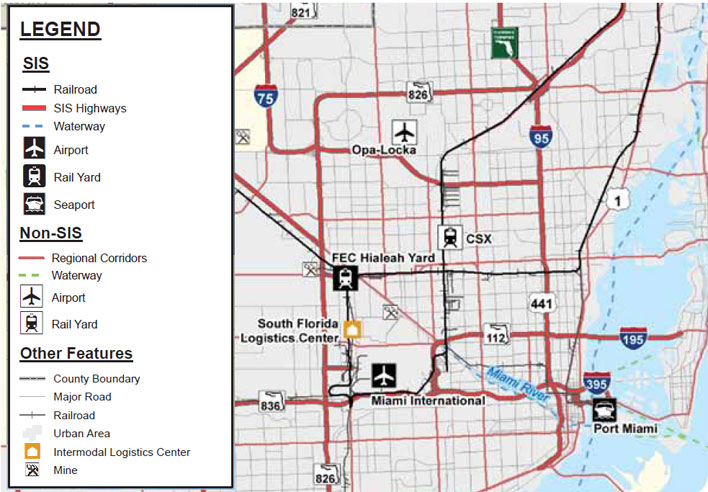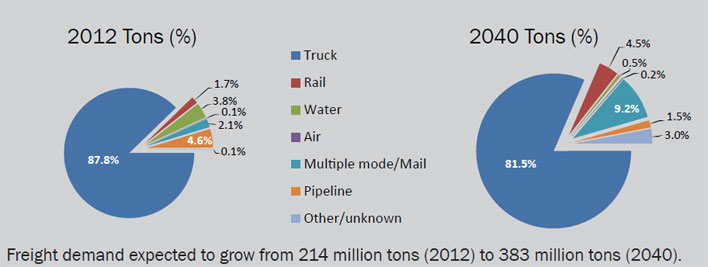U.S. Department of Transportation
Federal Highway Administration
1200 New Jersey Avenue, SE
Washington, DC 20590
202-366-4000
Freight Economy
Date: February 10, 2016
Our Host: Miami-Dade Metropolitan Planning Organization
| HIGHWAYS | I-75, I-95, I-395, Florida’s Turnpike Homestead Extension (HEFT), Okeechobee Road / US-27, US-1, SR-112, SR-836, SR-826, SR-874, SR-878, SR-924, SR-934 and NW36 Street (extension of Airport Expressway) | |
| RAILROADS | Intermodal Rail Yard – Hialeah, Florida East Coast (FEC) and CSX | |
| AIRPORTS | Miami International Airport Kendall-Tamiami Executive Airport | |
| WATERBORNE | Port Miami (Seaport), Miami River |

Source: FDOT
| Commodity | Value (millions $) | % of total |
|---|---|---|
| Machinery | 185,292 | 15% |
| Electronics | 169,669 | 14% |
| Precision instruments | 157,289 | 13% |
| Pharmaceuticals | 119,647 | 10% |
| Motorized vehicles | 84,458 | 7% |
| All commodities | 1,255,137 | 100% |
| Commodity | Tons (thousands) | % of total |
|---|---|---|
| Nonmetal min. prods. | 69,939 | 18% |
| Gravel | 40,809 | 11% |
| Newsprint/paper | 35,353 | 9% |
| Other foodstuffs | 20,173 | 5% |
| Gasoline | 19,959 | 5% |
| All commodities | 383,468 | 100% |
| Trade partner | Tonnage | % of total |
|---|---|---|
| Rest of Americas | 41,579 | 36% |
| Florida | 29,009 | 25% |
| Pennsylvania | 6,912 | 6% |
| Canada | 4,978 | 4% |
| Eastern Asia | 3,933 | 3% |
| Total outbound | 116,398 | 100% |
| Trade partner | Tonnage | % of total |
|---|---|---|
| Florida | 26,271 | 28% |
| Rest of Americas | 19,340 | 21% |
| Europe | 7,764 | 8% |
| Eastern Asia | 5,118 | 5% |
| Canada | 4,484 | 5% |
| Total outbound | 93,532 | 100% |
*2012 from FAF4, 2040 from FAF3

The Miami Dade Region will see multimodal freight activity nearly triple in value terms and nearly double in tonnage terms between 2012 and 2040.
The Miami Dade region represents the 15th highest volume of freight tonnage among U.S. metropolitan markets.
Miami Dade has a higher share of freight activity moving by truck (88%) as compared to the nation (70%; tonnage based).
Rail currently accounts for 2% of the Miami region’s freight tonnage, but rail activity is expected to more than triple by 2040.
Truck parking continues to be a priority in the region. The 595 Truck Stop is South Florida's only full service facility.
Florida DOT has study under way to investigate feasibility of full service truck stop/parking on state owned land at one identified site at the northwest corner of Turnpike and NW 12th Street.
The trade and transportation sector accounts for approximately 27% of the region's employment.
The majority of Miami Dade’s freight activity is domestic (72% by value and 89% by tonnage). By value, the region's international freight will expand nearly seven times over, fueled by strong growth with South America.
The Miami-Dade region includes four Foreign Trade Zones (FTZ) with several million square feet in distribution centers surrounding these zones. Intermodal access (including port, rail and air) is crucial for these facilities as they rely heavily on efficiency in regional transportation and logistics networks.
The Miami Dade region has fifteen of the top twenty freight bottlenecks in the state of Florida, according to a 2013 Florida DOT study.
The Port of Miami plays an integral role in freight activity in Southeast Florida. Local forecasts suggest doubling or tripling of cargo at the port over the next 20 years.
Sources for Freight Facts: FAF and ARC
To view PDF files, you can use the Adobe® Reader®.